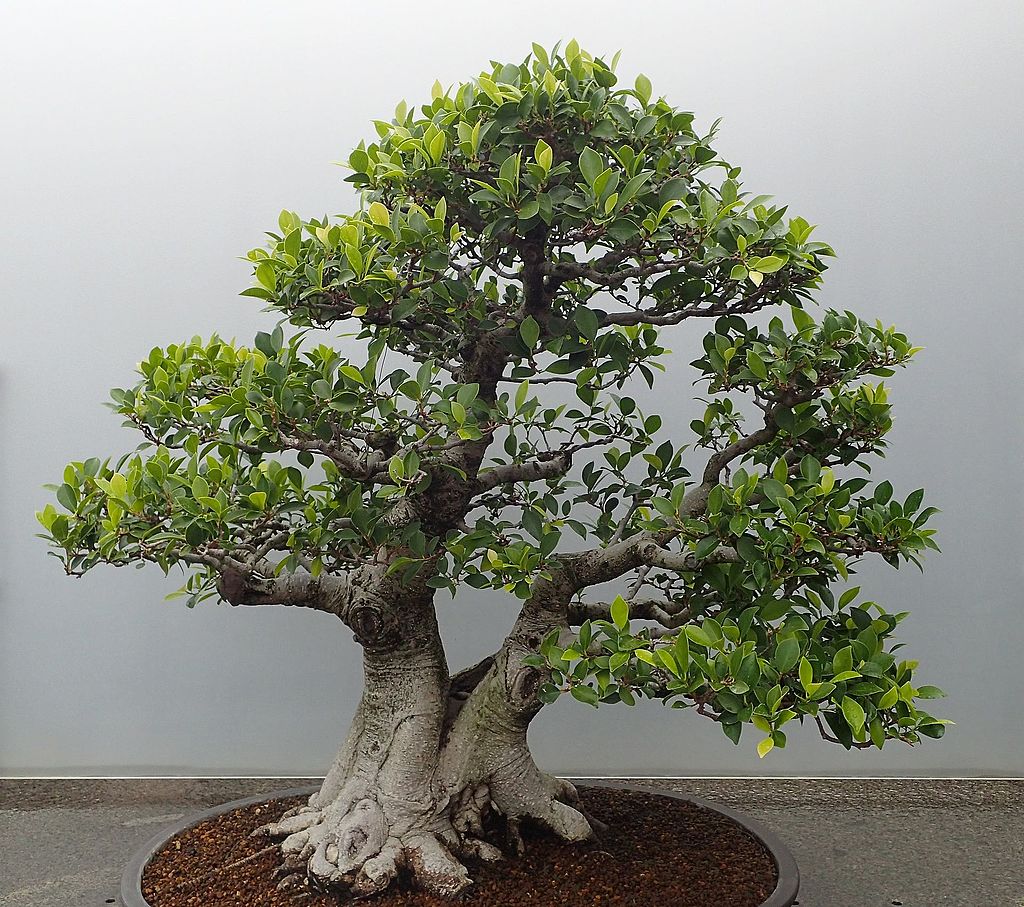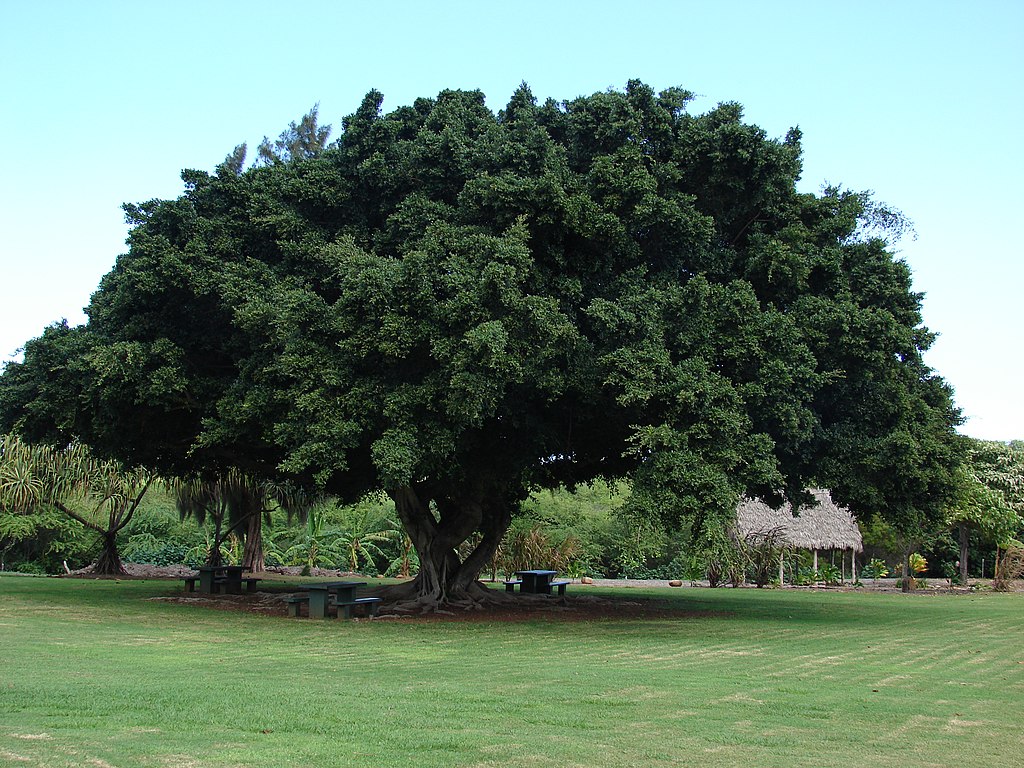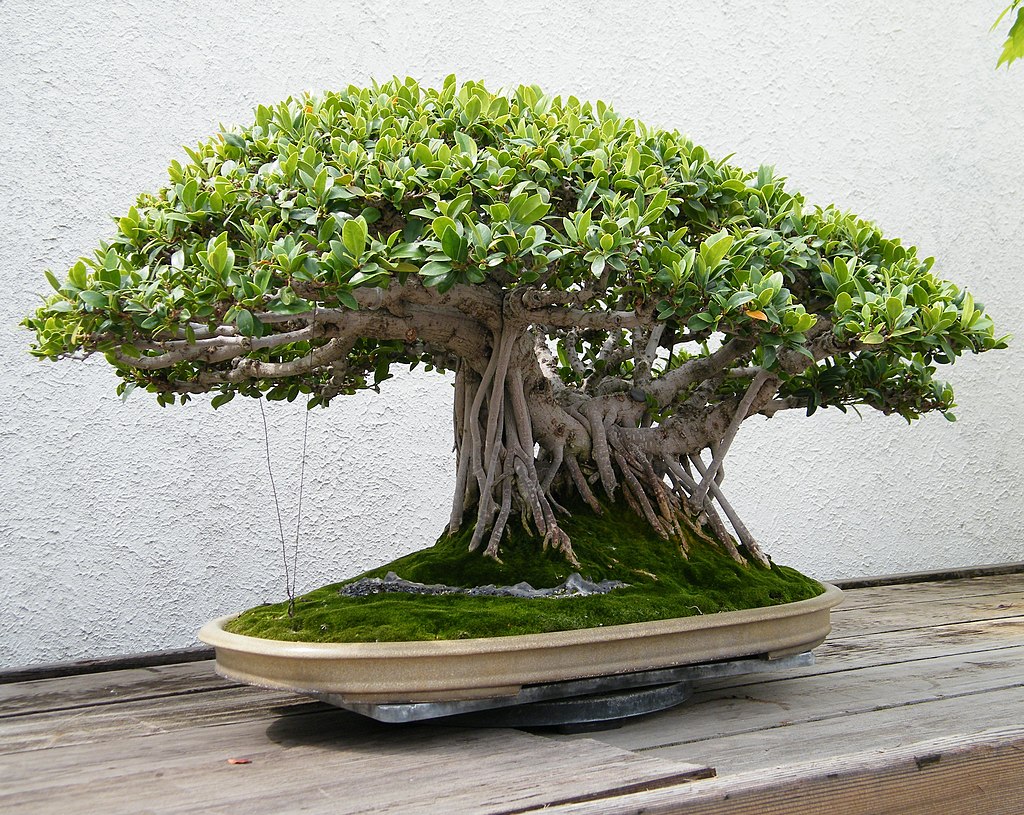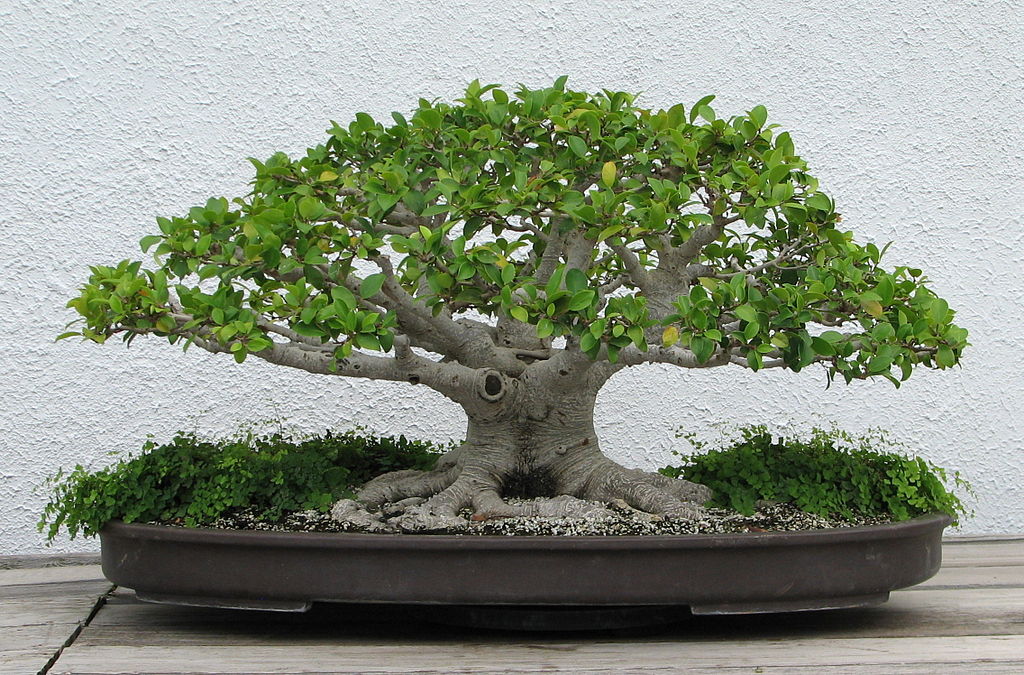Common: Golden Gate ficus, tiger bark ficus, Green Island ficus, Indian laurel, Chinese banyan
The oldest living bonsai, at 1200 years old, is a Ficus microcarpa, and there are many reasons that this tree has been a long-time favorite among bonsai growers:
- They are vigorous growers and can reach bonsai form much faster than many other varieties.
- They respond well to pruning and back bud profusely.
- They respond well to wiring, and you can form them into exotic shapes.
- The trunks and branches of multiple trees can be fused together to create even more exciting profiles.
- Aerial roots are fantastic, and this tree is a rockstar at making them.
- The leaves are reasonably sized and can be made even smaller over time.
Taking all of these factors into account has made ficus microcarpa one of the most popular species for bonsai. Their vigorous growth and forgiving nature make them an excellent choice for new growers, and their stunning appearance has earned them a place with experienced growers.

The Ficus microcarpa tree is prolific throughout the tropical world with localized cultivars, so people have given it many names. You will see this reflected in bonsai's as well; nurseries label specimens as Golden Gate ficus bonsai, tiger bark ficus bonsai, Green Island ficus bonsai, Indian laurel bonsai, and Chinese banyan bonsai. These are all either specific cultivars of ficus microcarpa or synonyms for ficus microcarpa.
Ficus microcarpa as a tree
Like with any bonsai, it is crucial to understand the natural environments where the tree thrives so that you can provide the optimal environment for your ficus microcarpa bonsai.

Ficus microcarpa trees are native to tropical Asia, Australia, and the southern pacific Islands. They have since been introduced as an ornamental species and taken hold in many tropical other regions, including North Africa and southern areas of the United States. Ficus microcarpa trees grow so aggressively that they are considered invasive in Hawaii, Florida, and the Caribbean. The Ficus microcarpa tree thrives in generally humid, sunny, and frost-free environments, where temperatures remain well above freezing.
Ficus microcarpa trees are members of the Moraceae (Fig) family, along with edible Fig, Banyan, jackfruit, and breadfruit trees. These trees can grow huge, up to 110.0 feet (33.53 meters) in height, 250 feet (76.2 meters) in crown spread under the right conditions. It is also a versatile and robust tree that can survive in constrained spaces like urban areas or the cracks in rock faces and will moderate its size to the resources and space available. Ficus microcarpa trees grow abundant aerial roots in humid environments, earning them the name curtain fig due to the dense curtain of aerial roots that often surround the tree's base.
These trees grow best in humid, rainforest environments with high levels of rainfall but can also live along riverbanks and in coastal regions. As rainforest trees, they do well in infertile soils with low levels of organic content.
If you want to learn more about this tree, this datasheet from Centre for Agriculture and Bioscience International is an excellent resource.
Lighting
Ficus microcarpa trees do best with lots of light - they are from the sunniest places on earth! Place your bonsai in the brightest spot you can find; a south-facing window with good exposure will work great. While the ficus can survive in lower light conditions, the growth will be long and spindly. You can supplement with artificial grow lights if needed. During warm months, or in tropical areas, your bonsai would benefit from outside time. To prevent leaf burn, start by placing it in the shade and then gradually moving it into sunnier locations over a week or so.
Temperature & Humidity
Ficus microcarpa trees are tropical trees and cannot tolerate frost or temperatures near freezing. While they can survive more extreme conditions, as a general rule, keep them above 50F (10C) and below 85F (29.5C) to avoid damage.
While tropical trees can actively grow year-round, it is best to give them a dormancy period if possible. To induce dormancy, move them into a cooler area, between 55F (12.7C) and 60F(15.5) for 6 to 8 weeks in the wintertime. This cool-down time will allow your bonsai to recharge and get ready for strong growth in the spring.
Ficus microcarpa trees love higher humidity; 60%-70% relative humidity is perfect, just like native jungle environments. While a human home typically stays in the correct temperature ranges for ficus microcarpa, they are often far drier than the ficus would prefer at 30-50% relative humidity. While they can survive in this humidity, they may lose leaves and grow sluggishly. You can raise the humidity by misting the plants daily or using a humidity tray. Keeping the humidity high is essential if you want to grow aerial roots.

Soil
While ficus microcarpa trees in the wild are so robust that they can grow in poor soil, you will want to be more careful with your bonsai version since it grows in a very constrained space. A safe bet is to use commercial bonsai soil since it is free-flowing and excels at developing roots in constrained areas.
You can easily mix your own if you know what you are doing. The critical aspects of the soil are that it is loose, not compacted so the roots can breathe and that it freely drains water because water-logged soil will result in root rot. Ficus microcarpa plants do well in soil with ample volcanic materials like pumice, lava rock, vermiculite, and perlite because these inorganic materials are lightweight, free-draining, and provide excellent aeration. Ficus microcarpa bonsais, especially young ones in training and pre-bonsai states, also benefit from organic matter mixed in the soil. We recommend a mix of 60% inorganic material (pumice, lava, vermiculite, sand, etc.) and 40% organic materials (pine/fir bark, coco coir, peat moss, composted forest products, etc.).
Ficus microcarpa bonsais prefer an almost neutral soil pH, between 6 and 7. You can add peat moss or pine bark to lower pH (more acidic), and lime will raise the pH (more alkaline). Be careful when adjusting pH and test your soil since you can easily create an environment too caustic or acidic for the plant to survive.
Water
Follow the same rule of thumb for ficus microcarpa bonsai as with most varieties of bonsai: let the soil almost dry out between waterings but do not let it completely dry out. In the summertime, this likely means watering every day, depending on the size of the container. In cooler weather and while in dormancy, watering will be less frequent.
Make sure to water thoroughly each time until the water runs from the bottom of the pot. Doing this will help ensure that all of the soil gets wet so the roots will expand to the entire potting area, and the runoff will help remove excess salts left by chemical fertilizers.
Fertilizer
Ficus microcarpa bonsai do well when there are ample nutrients available. Use a balanced, water-soluble fertilizer once a week during the peak growing season and once a month during the cooler seasons. Follow the manufacturer's instructions; overfertilizing can lead to burnt leaf tips, and under fertilizing can lead to sluggish growth, either will eventually kill your bonsai.
Repotting
Ficus microcarpa trees are aggressive root growers and will quickly fill up a pot. You should check your pot at least once a year and repot if they are root-bound. These trees handle root pruning very well, so they can be replanted in the same pot for several seasons.

Pruning & Wiring
Ficus microcarpa bonsai respond very well to pruning and wiring, allowing you to form them into exotic shapes. Prune and wire during the active growing period. You can completely defoliate the tree every other spring to get a reduced leaf size.
When pruned, they back bud profusely and produce new shoots after a hard cutback or even a full trunk chop. They bleed a white latex-based sticky sap heavily when cut. While it can irritate humans and pets, it helps the tree heal quickly and lowers the risk of infection. Always sanitize your tools before pruning bonsai to reduce the risk of infection or cross-contamination.
With wiring, the primary concern is that they grow so fast that the wire can cut into the bark. Check the wiring frequently and remove or replace it when you see it cutting into the bark. Don't worry if you get some scarring; it will heal over time. You can also train your Ficus microcarpa bonsai using the clip-and-grow approach by constantly cutting and shaping new growth.
Propagating
You can make new trees from Ficus microcarpa bonsai cuttings with ease. You will need to remove most of the leaves since the cutting will not have a root system to support the water required for photosynthesis until it develops roots. Put the cuttings into water or moist soil in a humid environment and mist them while developing roots. Cuttings root best in warm weather, but a heating pad can help in the cold months. Please keep them in low light until they grow a root system to support photosynthesis, which takes between 7 days and three weeks.